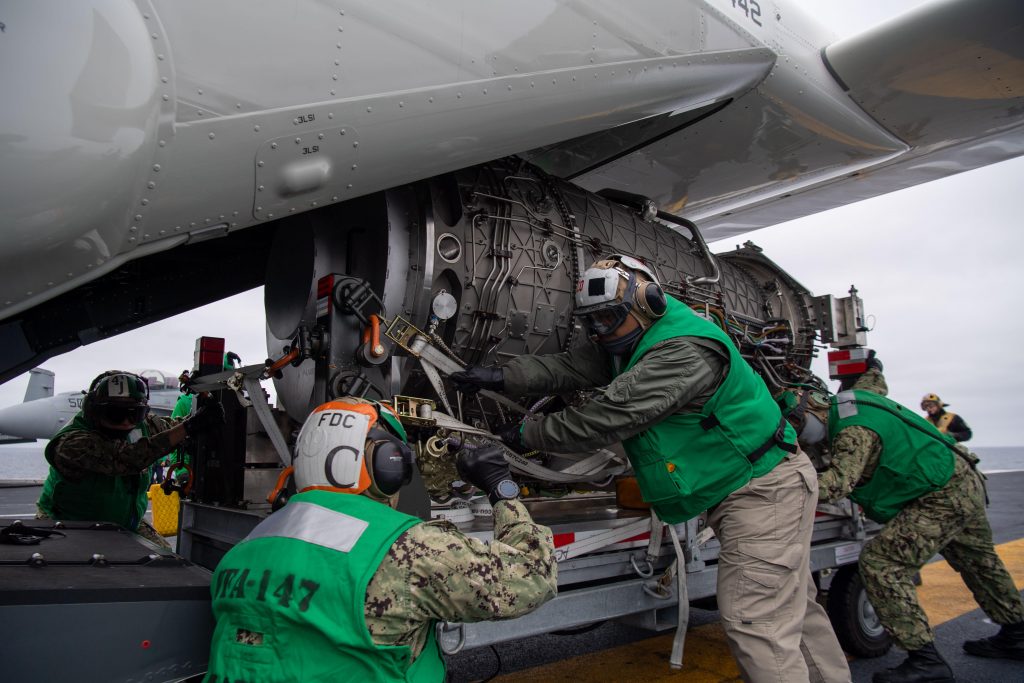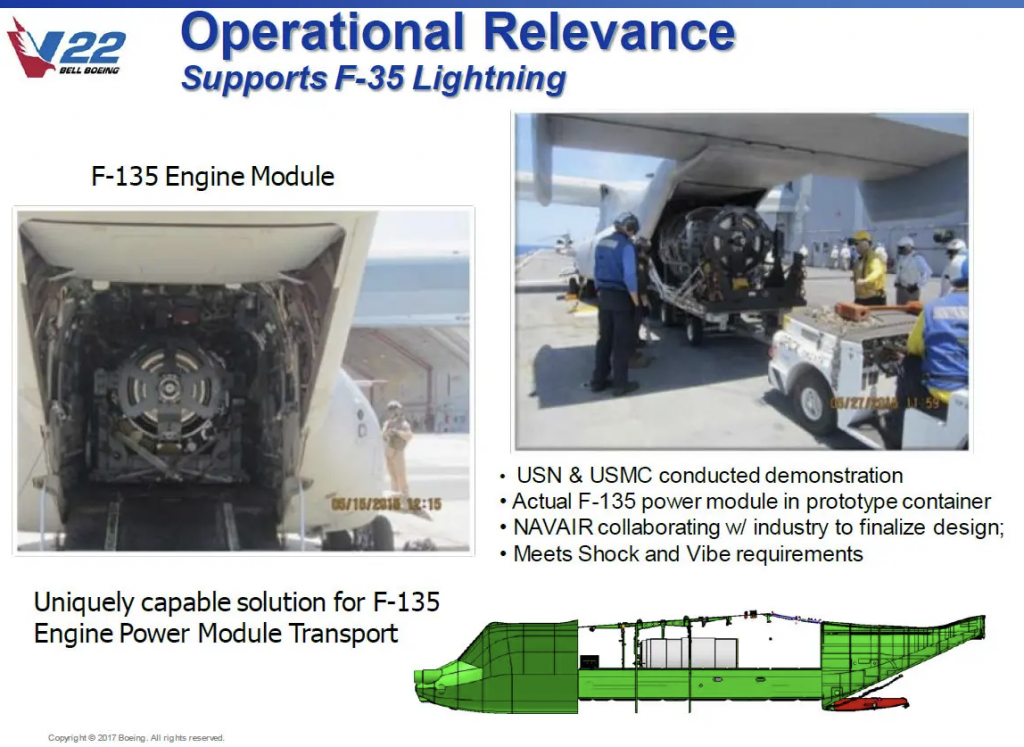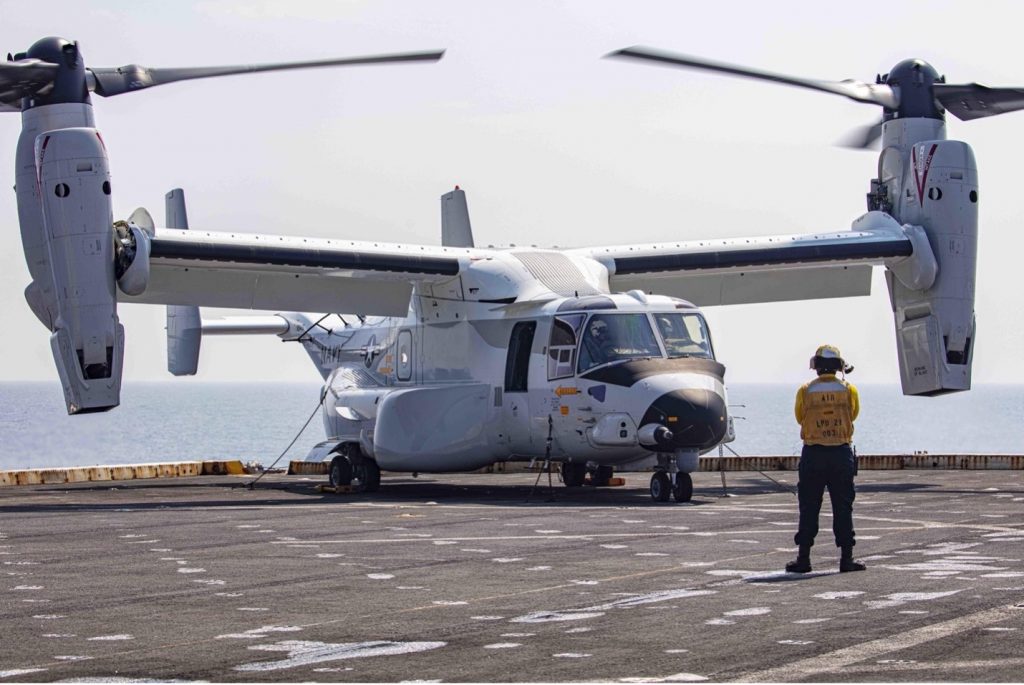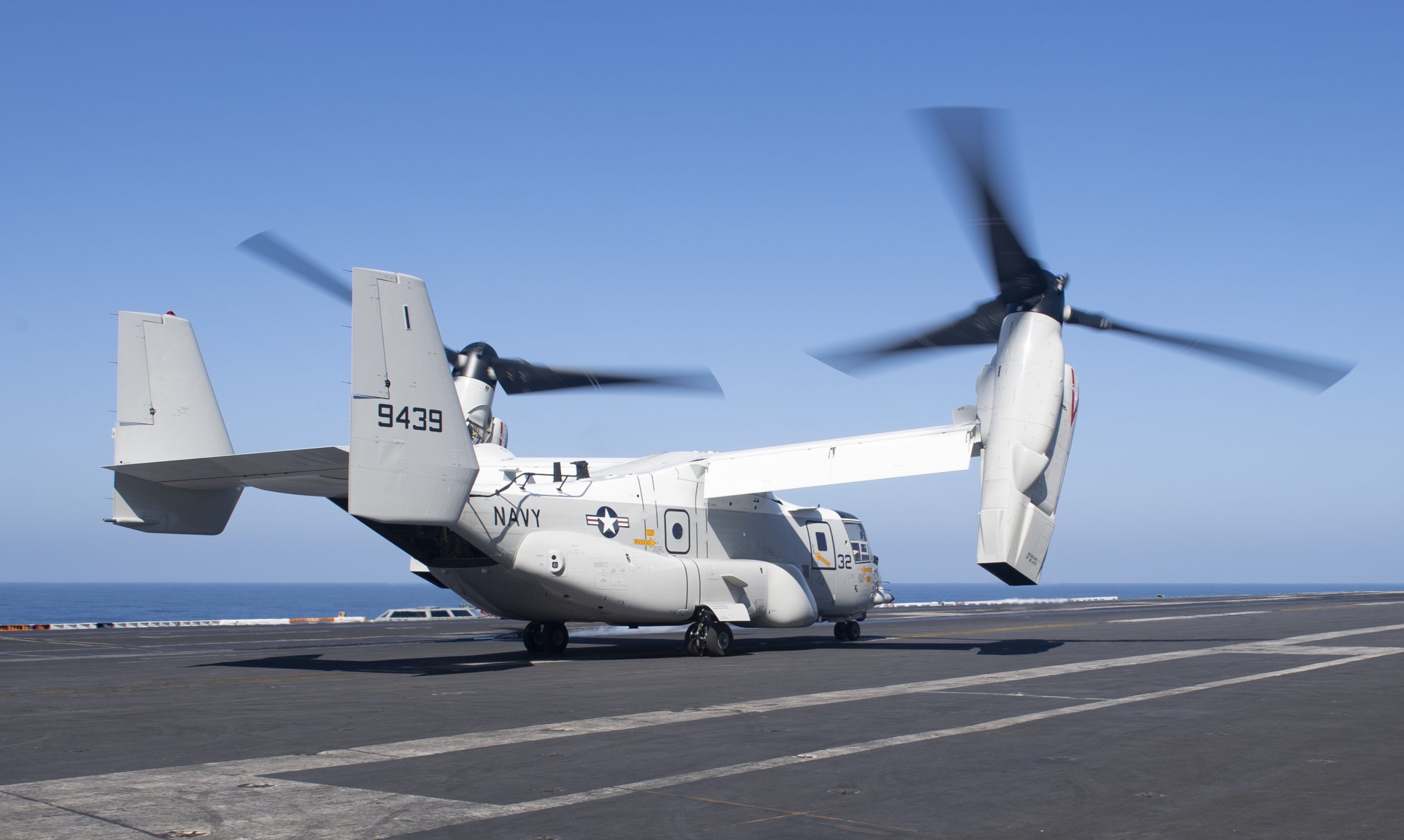The CMV-22B is replacing the C-2 as the carrier on-board delivery system for the large deck carriers.
But that is no all of which can be subsumed under the new concept of on-board delivery.
First, the Secretary of Defense visited the USS Nimitz on February 25, 2021 via CMV-22B “delivery,”
This is seen in the featured photo.
Second, there is a core reason the CMV-22B is replacing the C-2, and that is because it can deliver the largest module of the F-35 engine, a new and important capability for the carrier fleet, which, is of course, already operating from allied and USMC fleets.
That on-board delivery first occurred at sea on February 11, 2021.
As reported by the U.S. Navy on February 26, 2021:
The “Titans” of Fleet Logistics Multi-Mission Squadron (VRM) 30 and members of Carrier Air Wing (CVW) 2 successfully delivered an F-35C power module aboard USS Carl Vinson (CVN 70) in the U. S. Navy’s first, at-sea replenishment for this component.
This success follows a November 2020 milestone, during which VRM-30, CVW-2 and Vinson conducted the Navy’s first landings, take-offs, and refueling of a Navy CMV-22B Osprey from an aircraft carrier.
The at-sea power module replenishment evolution consisted of loading, transporting and unloading the F135 power module from a shore-based location to the carrier by way of a CMV-22B. The power module is an engine component used by all three F-35 Lightning II variants.
The CMV-22B is the U.S. Navy version of the V-22 Osprey, a multi-engine, dual-piloted, self-deployable, medium lift, vertical takeoff and landing (VTOL) tilt-rotor aircraft. The CMV-22B can transport cargo and passengers as far as 1,150 nautical miles; provides enhanced survivability and beyond-line-of-sight communications; and has the required cargo capacity and fast cargo loading/unloading. Coupled with its ability to transport the F-35 power module inside its cargo bay, CMV-22B is the ideal choice to provide required carrier on-board delivery capabilities for F-35C operations at sea. The delivery marks a milestone in the integration of CMV-22B to the Carrier Air Wing, validates the F135 modular maintenance concept at sea, and most importantly supports future carrier air wing deployments with next-generation platforms.
“The CMV-22B is a great addition to the carrier air wing,” said Capt. Matt Thrasher, commander, CVW-2. “The Osprey is a robust logistical platform that not only supports the F-35C but also gives the entire air wing increased range and transport capacity. Its addition to our team ensures that CVW-2 remains ready to perform as-advertised while on deployment.”
CVW-2 is currently embarked aboard Vinson under the command of Carrier Strike Group (CSG) 1.
CVW-2 is leading the charge in introducing and integrating the next generation of aircraft and capabilities in the Fleet as the U.S. Navy’s first Carrier Air Wing to deploy with the F-35C Lightning II, E-2D Hawkeye and the CMV-22B Osprey. The Navy’s next iteration of the Carrier Air Wing will be more lethal and survivable through the integration of organic fourth-generation kinematics and fifth-generation information and survivability, increased command and control and airborne electronic attack capacity, all sustained with a reliable logistical support platform.

“With the addition of the newest fifth-generation aircraft, the Navy has delivered the world’s most capable, lethal and ready air wing to our strike group,” said Rear Adm. Timothy J. Kott, commander, CSG-1. “Delivering the right balance of presence and power, including airpower supremacy, strike groups continue to be one of our nation’s primary on-call assets in times of need. By maintaining a lethal, ready strike group, manned by the world’s most skilled Sailors and outfitted with the best equipment, fifth generation aircraft will help America maintain our advantage at sea and protect our nation for years to come.”
Capable of embarking both the F-35C and the CMV-22B, Vinson is the first aircraft carrier equipped to support fifth-generation aircraft. With its recent modifications, no other weapons system has the responsiveness, endurance, multi-dimensional might, inherent battlespace awareness or command and control capabilities of the Vinson and CVW-2.
Upgrades included enhanced jet blast deflectors able to take the increased heat generated by the F-35C and the Autonomic Logistics Information System (ALIS), the new computer network that supports the unique maintenance and tactical operations functions of the advanced aircraft. 
“Our crews and staffs have done a fantastic job during integrated operations with the new aircraft and associated upgrades,” said Capt. P. Scott Miller, Vinson’s commanding officer. “We are truly a team. The successful replenishment of the power module is another testament to that team and our Sailors, who are the most dedicated, best trained and well educated in the world. The continued professionalism and warfighter spirit they demonstrate each and every day is the number one key to our success time and time again.”
Vinson is currently completing a series of “work ups” and certifications in preparation for future operational tasking.
Third, the CMV-22B is coming to the large deck carrier at a time when the U.S. Navy is reworking blue water maneuver operations.
In such operations, logistics resupply is crucial.
And as the Military Sealift Command works through how to do so with limited ship numbers, clearly the CMV-22B can play a role in ship-to-ship resupply as demonstrated in the “Blackjacks” testing landings on LPD-class landings last year.
According to a U.S. Navy article published on October 16, 2020:
A team of pilots and engineers from Air Test and Evaluation Squadron (HX) 21 recently joined colleagues from other Navy and Marine Corps commands to conduct MV-22 Osprey landing and ship compatibility tests aboard the amphibious transport dock USS New York (LPD 21). The testing also included the first shipboard landings for the Navy’s new CMV-22B Carrier Onboard Delivery (COD) variant of the Osprey.
Over the course of the 10-day detachment in July, the test team flew 180 shipboard approaches and landings, totaling just under 45 hours of flight testing, to develop a better understanding of how pilots can successfully avoid the effects of a phenomenon called “recirculation” when flying to and from ships. Recirculation occurs when the downwash from the aircraft’s rotors is reflected off a ship’s deck back into the rotors’ rotation arc, causing the aircraft to suddenly lose lift.
The team performed low-power-margin testing, and developed procedures for day and night approaches that would minimize the effects of recirculation. The outcome of this testing was to identify better control limits for the aircraft, and develop guidance and procedures that will improve safety for the MV-22 fleet. The testing clearly demonstrated the value of developmental testing.
“We hit 100% of the high priority test points,” said Marine Corps Maj. Nathaniel Ross, HX-21’s operations officer. “And even with a whole lot of smart people working on our test plan to help us understand the interactions between the ship and the aircraft, when we actually got out to the ship and began flying the test points, we still found things (Issues) that we weren’t necessarily looking for, or expecting to find. But, we were able to adjust our test plan quickly, to account for them, which allowed us to make recommendations to the class desk for envelope adjustments.”
Teamwork was crucial to the success of the mission, Ross said. Most of the people on the test team, which numbered 50 pilots and engineers at its peak, had served together on a previous detachment, so they had already learned to work together. The test program involved members of Marine Helicopter Squadron (HMX) 1 based at Marine Corps Base Quantico, Va., Marine Heavy Helicopter Squadron (HMH) 464 based at Marine Corps Air Station New River, Jacksonville, N.C., and Expeditionary Strike Group 2 based in Norfolk, Va.

Ross identified the leadership and crew of the New York for particular praise. “From the captain all the way down to the people pulling the chocks and chains, everyone understood the importance of this test and how the lessons learned from it will save lives,” Ross said. “The whole crew understood and embraced that. It was pretty amazing to watch.”
During the detachment HX-21’s CMV-22B COD aircraft made two delivery trips to the New York, ferrying maintainers and their supplies. Normally a test team and their equipment would be loaded aboard a ship pierside; but because the New York was underway at the outset, everything for the tests had to be flown to and from the ship.
“The CMV-22B is a great choice for that mission,” said Navy Lt. Gavin Kurey, a test pilot and project officer at HX-21 who flew the first of the two COD trips to the New York with the squadron’s then-commanding officer, Lt. Col. John Ennis, and crew chief Brian Neseth. “As we were planning the test detachment on-load missions, we realized that the Navy aircraft was going to be a viable resource for helping our team to accomplish its goals. And the aircraft just plugged right into its intended role perfectly.”
Kurey said that although the ferry flight was strictly business, everyone on board was aware that they were making history. “The crew was certainly excited, and so were all the passengers, who knew that they were the first people to be ferried out to a ship at sea in the new COD Osprey,” Kurey recalled. “Everyone was buzzing with positive energy the whole flight and the crew of the New York was excited that their ship was going to be the first to have a Navy Osprey land on it.”
The CMV-22B is designed to carry up to 6,000 pounds of cargo and/or personnel and operate up to a range of 1,150 nautical miles. The aircraft will replace the venerable C-2A Greyhound, which has been fulfilling the COD role since 1966.
Ross said that in addition to providing valuable data to engineers and designers about the performance envelope of the Osprey family of tilt-rotor aircraft when operating aboard LPD-class ships, the detachment also provided valuable lessons in teamwork for the squadron that will benefit future test activities. “Everyone was at the right place at the right time to make the mission a success, and that was due to the professionalism of everyone involved,” Ross said.
Nicknamed the “Blackjacks,” HX-21 provides developmental flight test and evaluation of rotary-wing and tilt-rotor aircraft and their associated airborne systems in support of U.S. Navy and Marine Corps training, combat, and combat support missions. The squadron can trace its roots at NAS Patuxent River back to 1949, when the then-Naval Air Test Center first established a rotary-wing test division. Today, HX-21 teams are engaged in testing six families of aircraft, including the CH-53K King Stallion, the MV-22 and CMV-22B Osprey, and the Presidential helicopter fleet.


